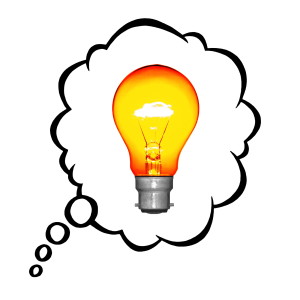The following is an excerpt from Michael Kerr’s book, The Humor Advantage: Why Some Businesses Are Laughing All the Way to the Bank
It’s worth taking the time to consider why it is that humor and creativity are such close cousins if, for no other reason, than to reinforce the need to intentionally build a fun workplace culture and not leave humor to chance.
Indeed the relationship is so close that some creativity researchers even consider humor to be a subset of creativity. Others believe that although they are strongly linked, humor and creativity  ought to be considered as completely separate but definitely overlapping domains. From my perspective, I go back to the rubber chicken and egg cycle: it takes creativity to generate humor, and thinking humorously lays many creative eggs.
ought to be considered as completely separate but definitely overlapping domains. From my perspective, I go back to the rubber chicken and egg cycle: it takes creativity to generate humor, and thinking humorously lays many creative eggs.
Several experiments have tried to determine whether or not humor drives creativity. Israeli psychologist Avner Ziv found that verbal creativity test scores for grade ten students improved considerably after the students listened to a comedian. Their scores were better in terms of increased fluency, flexibility, originality and overall creativity.
Studies by University of Maryland psychologist Alice Isen also found, as many other studies have also demonstrated, that positive emotions support greater creative thinking. In Isen’s study, she used humorous films to create mirthful feelings in participants, which then translated into enhance creativity. Harvard researcher Moshe Bar agrees with another version of my rubber chicken and egg theory, having found that happier people tend to come up with more ideas but that also, if you want to be happier, come up with more ideas!
There’s certainly something to the notion that humor’s power to shift us into a more positive mood is part of the creative equation here. A study by Theresa Ambile and Steven Kramer found that there was a 50% increase in the odds of having a creative idea on days when people were in a positive mood, and this creative bump can last up to two days.
All of this lends credence to the craziness that some teams exhibit before sitting down (or during) a high energy brainstorm session. Some teams brainstorm something completely silly to lighten the mood and fire up the brains while others might try a theater improv game or a spirited game of Pictionary. One of my clients blows bubbles before a brainstorm, another client has been known to have a water gun fight before sitting down to meet.
As a former theater improvisational performer I can certainly attest to the benefits of warming a team up through play. Going into an improv performance without doing any warm exercises is akin to heading out for a run without doing an stretching. Consider the benefits of some playful humor being injected into your meetings:
- It’s hard to be creative when participants are stewing about the work issue they left behind or thinking about tomorrow’s big meeting. Playing a game clears minds and helps people focus on
 the present.
the present.
- Playing reduces artificial hierarchical barriers. When a team plays together and laughs together, they become a united group of people sharing a fun experience.
- It’s hard to be open and creative when people are feeling stressed, and humor and play is a quick way to de-stress the team, relaxing people both mentally and physically.
- Humor, as we’ve seen, can put people in a positive frame of mind where they are focused on possibilities, not the probabilities of things not working out.
- Humor tends to enhance mental flexibility and helps people to process incongruities better, both key ingredients in creative thinking.
- Play can encouraging greater participation and communication from everyone on a team.
- Play, especially when it’s in the form of a theater improv exercise, can lower people’s inhibitions and create a safe environment for risk-taking. By lowering inhibitions, it’s hoped that participants then feel far more comfortable throwing out truly wild ideas that perhaps they would have kept themselves had those guards not come down. In fact, as Tina Fey outlines in her book Bossypants, the key principles of comedic improv are perfectly aligned with the goals of an energetic brainstorm and a creative culture: always agree with an initial offer and say “Yes”; build on rules with a “Yes, and…” approach; there are no mistakes in improv, only opportunities.
I’ve perhaps not seen the role of play at work better summarized than in the words the manufacturing and design company Milliken uses to describe their overarching philosophy:
“The spirit of play invigorates the curiosity to discover, the liveliness to imagine, and the will to take initiate. The openness of play encourages transparency, trust, and risk-taking. The creative energy of play uncovers unique insights, stimulates deep scientific inquiry, and inspires meaningful design – from these our innovations are born…Purposeful play makes us a team. It is why our customers want us on their side. Because we play with purpose, we play with passion, we play to win.”
It’s no small wonder that a Humor at Work survey of more than 800 people found that the preferred catalyst for creative thinking is play and humor.
There’s likely a tangential link here to what some companies do to encourage ideas in their business. Toshiba, HP, 3M, W.L. Gore and Google allow employees anywhere from 10-20% of their work time to work on their own projects and ideas – whatever they are passionate or curious about. In essence what these companies are doing though is giving their employees to time to play on their own pet projects, and all have experienced tremendously innovative ideas as a result. Google’s program, for example, known as Innovation Time Off, has led to an estimated 50% of all their new products, including Gmail and AdSense.
Of course, once you’ve generated those brilliant ideas, you’re going to need to keep a sense of humor about you as you move onto the final two stages of the creative process, namely deciding on the best idea and acting on it.
Michael Kerr is a Hall of Fame international business speaker who travels the world researching, writing, and speaking about inspiring workplace cultures. He is the author of 8 books, including, “The Humor Advantage,” The Jerk-Free Workplace,” and “Hire, Inspire, and Fuel Their Fire.”


